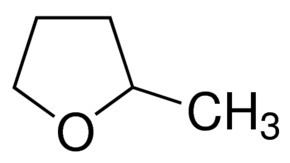Density 854 kg/m³ | Formula C5H10O | |
 | ||
2-Methyltetrahydrofuran is an organic compound with the molecular formula CH3C4H7O. It is a highly flammable mobile liquid. It is mainly used as a replacement for THF in specialized applications for its better performance, such as to obtain higher reaction temperatures, or easier separations (as, unlike THF, it is not miscible with water). It is derived from furfural and is usable as a biofuel.
Contents
Structures and properties
2-Methyltetrahydrofuran is "inversely soluble" in water. That is, its solubility decreases with increasing temperature, which is a rare property. 2-Methyltetrahydrofuran behaves like tetrahydrofuran as a Lewis base in organometallic reactions.
Preparation
2-Methyltetrahydrofuran is usually synthesized by catalytic hydrogenation of furfural.
OC4H3CHO + 4 H2 → OC4H7CH3 + H2OFurfural is produced by the acid-catalyzed digestion of pentosan sugars, C5 polysaccharides, in biomass. Thus, the raw materials of 2-methyltetrahydrofuran are renewable biomass rich with cellulose, hemicelluloses, and lignin, such as corncobs or bagasse and other plant and agricultural waste.
2-Methyltetrahydrofuran can also be produced starting from levulinic acid. Cyclization and reduction gives γ-valerolactone:
This lactone can be hydrogenated to 1,4-pentanediol, which can then be dehydrated to give 2-methyltetrahydrofuran:
2-Methyltetrahydrofuran has one chiral center, so it exists in two enantiomeric forms. The commercial processes involving hydrogenation gives a racemic mixture of the two. The asymmetric synthesis of (S)-(+)-2-methyltetrahydrofuran can achieved by using a wool–rhodium complex as a chiral catalyst for hydrogenation of methyl furan.
Applications
2-Methyltetrahydrofuran is mainly used as a higher boiling substitute for tetrahydrofuran as a specialty solvent. It also is used in the electrolyte formulation for secondary lithium electrodes and as a component in alternative fuels. It is a valued solvent for low temperature reactions. 2-Methyltetrahydrofuran forms a glass, which does not crystallize, and is frequently used as a solvent for spectroscopic studies at −196 °C.
Other common uses of 2-methyltetrahydrofuran is as a solvent for Grignard reagents used in organometallic and biphasic chemical processes, because of the oxygen atom's ability to coordinate to the magnesium ion component of the Grignard reagent, or to azeotropically dry products. The use of 2-methyltetrahydrofuran provides very clean organic-water phase separations. It is a popular, but costlier substitute for tetrahydrofuran.
2-Methyltetrahydrofuran is approved by the United States Department of Energy as an additive to gasoline.2-Methyltetrahydrofuran Furfural and other partially hydrogenated/reduced furyl compounds between it and 2-methyltetrahydrofuran (furfuryl alcohol, methylfuran, tetrahydrofural alcohol) have a tendency to polymerize and are quite volatile. 2-Methyltetrahydrofuran itself, however, is more stable and less volatile, and thus is suitable for use as a motor fuel.
